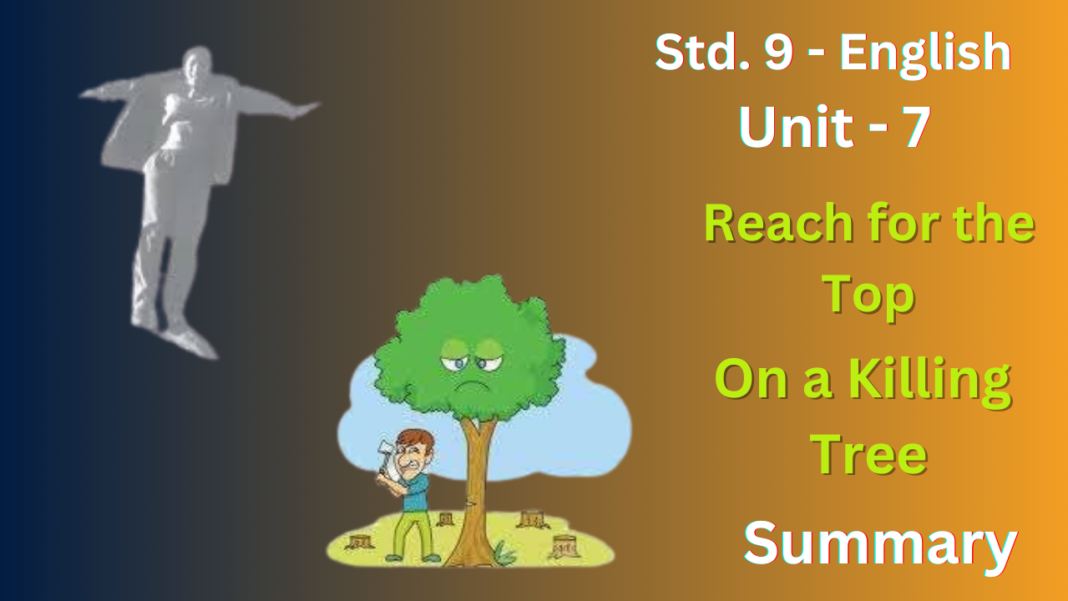Reach for the Top
“Reach for the Top” in your 9th-standard English subject is actually two separate stories about remarkable women who achieved success despite challenges. Here’s a summary of each part:
Part 1: Santosh Yadav
- Santosh Yadav was the first woman in the world to climb Mount Everest twice.
- The story highlights her struggle against societal norms. Being born a girl in Haryana, India, she faced pressure to marry young and live a traditional life.
- However, Santosh was determined to pursue her dream of mountaineering.
- She overcame financial limitations, lack of support, and even family disapproval to achieve her goals.
Part 2: Maria Sharapova
- Maria Sharapova is a successful tennis player who reached the number one ranking in the world rankings at a young age.
- The story focuses on her dedication and hard work. Maria left her family in Russia at a young age to train in Florida, USA.
- She faced a rigorous training regime and immense pressure to succeed.
- Despite the challenges, Maria’s talent and dedication propelled her to become a world-renowned tennis champion.
Overall Message
“Reach for the Top” celebrates the achievements of these two women and highlights the importance of:
- Determination: Overcoming obstacles and pursuing dreams with unwavering focus.
- Hard Work: Success requires dedication, effort, and a willingness to sacrifice.
- Breaking Barriers: Challenging societal expectations and defying limitations.
- Following Your Passion: Pursuing your dreams despite challenges, leading to a fulfilling life.
Additional Notes:
- The chapter may also discuss the importance of self-belief, perseverance, and the power of setting goals.
- It encourages readers to find their own passions and strive for excellence, regardless of their background or circumstances.

Thinking about the Text
I. Answer these questions in one or two sentences each. (The paragraph numbers within brackets provide clues to the answers.)
1. Why was the ‘holy man’ who gave Santosh’s mother his blessings surprised? (1)
Ans : The “holy man” was surprised because Santosh’s mother sought blessings for a daughter, which was likely against the social norms and expectations of their society at that time.
2. Give an example to show that even as a young girl Santosh was not ready to accept anything unreasonable. (2)
Ans : Santosh preferred wearing shorts while other girls her age wore sarees or traditional outfits. This seemingly small act of defiance showcases her independent spirit and unwillingness to conform to societal expectations, especially regarding gender roles and clothing norms.
3. Why was Santosh sent to the local school? (3)
Ans : It could have been due to following a prevailing family custom where girls received education at the village school. Alternatively, her parents, while supportive, might have prioritized ensuring basic literacy for Santosh rather than seeking a more expensive private education.
4. When did she leave home for Delhi, and why? (4)
Ans : Santosh left home for Delhi when she turned sixteen. The text likely mentions her motivation for leaving was to pursue higher education and escape limitations placed upon her in her village.
5. Why did Santosh’s parents agree to pay for her schooling in Delhi? What mental qualities of Santosh are brought into light by this incident? (4)
Ans : Santosh’s parents likely agreed to fund her Delhi education due to a combination of her unwavering determination and their recognition of her potential. The story might describe her proposing to work part-time to cover costs, highlighting her independence and resolve. This incident reveals Santosh’s ambition, self-reliance, and perseverance in overcoming hurdles to achieve her goals.
II. Answer each of these questions in a short paragraph (about 30 words).
1. How did Santosh begin to climb mountains?
Ans : The story likely describes Santosh’s initiation into mountaineering either through her curiosity about villagers climbing the hills or by encountering a group of mountaineers herself.
2. What incidents during the Everest expedition show Santosh’s concern for her team-mates?
Ans : Two examples likely depict Santosh’s concern for her teammates: sharing her oxygen and aiding a struggling climber during the Everest expedition.
3. What shows her concern for the environment?
Ans : Santosh’s environmental concern likely shines through her efforts to clean garbage on expeditions or advocating for sustainable practices in mountaineering.
4. How does she describe her feelings at the summit of the Everest?
Ans : The text about Santosh Yadav likely describes her feelings at the summit of Everest as indescribable. This emphasizes the overwhelming nature of the experience and the difficulty of capturing it in words.
5. Santosh Yadav got into the record books both times she scaled Mt. Everest. What were the reasons for this?
Ans :
Youngest Woman on Everest (First Ascent): When she first scaled Everest, she became the youngest woman in the world to achieve this feat at the age of 20. This was a significant accomplishment, breaking existing records for female climbers on Everest.
First Woman to Summit Everest Twice: Her second ascent of Everest marked another record. Santosh became the first woman ever to climb Mount Everest twice. This showcased her exceptional determination, resilience, and mountaineering skills.
III. Complete the following statements:
- From her room in Kasturba Hostel, Santosh used to ………………
- When she finished college, Santosh had to write a letter of apology to her father because ………………
- During the Everest expedition, her seniors in the team admired her ……………… while ……………… endeared her to fellow climbers
Ans :
- … see the villagers going up the hill and suddenly vanishing after a while.
- … she was going directly for training and not home which she should have done.
- … climbing skills, physical fitness and mental strength while working together endeared her to fellow climbers.
IV. Pick out words from the text that mean the same as the following words or expressions. (Look in the paragraphs indicated.)
- took to be true without proof
……………………………… - based on reason; sensible; reasonable
……………………………… - the usual way of doing things (para 3):
……………………………… - a strong desire arising from within (5):
- the power to endure, without falling
ill (7): …………………….
Ans :
- blessing
- rational
- custom
- urge
- resistance/endurance
Thinking about the text
Working in small groups of 4-5 students, go back over the two passages on Santosh Yadav and Maria Sharapova and complete the table given below with relevant phrases or sentences.
| Points of Comparison/Contrast | Santosh Yadav | Maria Sharapova | |
| 1. | Their humble beginning | ||
| 2. | Their parents’ approach | ||
| 3. | Their will power and strong desire to succeed | ||
| 4. | Evidence of their mental toughness | ||
| 5. | Their patriotism |
Ans :
| Points of Comparison/Contrast | Santosh Yadav | Maria Sharapova |
| 1. Their humble beginning | – Born into a modest family in a rural village in Haryana, India. – Faced societal norms that limited girls’ education and opportunities. | – Born into a working-class family in Siberia, Russia. – Left her family at a young age to train for tennis in the US. |
| 2. Their parents’ approach | – Supportive but hesitant due to societal expectations and financial limitations. – Santosh might have had to convince them of her dream. | – Father recognized her talent and pushed her towards tennis training. – Mother stayed behind in Russia to support the family financially. |
| 3. Their will power and strong desire to succeed | – Overcame financial limitations, societal disapproval, and lack of formal training to pursue mountaineering. – Worked part-time to fund her education and mountaineering pursuits. | – Displayed exceptional dedication and work ethic at a young age. – Underwent a rigorous training regime despite the challenges of being away from family. |
| 4. Evidence of their mental toughness | – Faced harsh weather conditions, physical challenges, and potential dangers while climbing Everest. – Bounced back from setbacks and continued to pursue her dream of scaling Everest twice. | – Dealt with the pressure of intense training and competition from a young age. – Maintained focus and determination despite the loneliness of being away from family. |
| 5. Their patriotism | – The story might mention her sense of accomplishment in achieving a feat for India. – Could have a deep connection to her homeland despite limitations placed upon her. | – The text might mention her representing Russia in competitions or displaying national pride. |
Thinking about language
Look at the following sentences. They each have two clauses, or two parts each with their own subject and verb or verb phrase. Often, one part (italicised) tells us when or why something happened.
- I reached the market when most of the shops had closed. (Tells us when I reached.)
- When Rahul Dravid walked back towards the pavilion, everyone stood up. (Tells us when everyone stood up.)
- The telephone rang and Ganga picked it up. (Tells us what happened next.)
- Gunjan has been with us ever since the school began. (Tells us for how long he has been with us.)
I. Identify the two parts in the sentences below by underlining the part that gives us the information in brackets, as shown above.
1. Grandfather told me about the old days. All books were printed on paper then.
Ans : Grandfather told me about the old days, when all books were printed on paper.
2. What do you do after you finish the book? Perhaps you just throw it away.
Ans : Perhaps you just throw the book away after reading it.
3. He gave the little girl an apple. He took the computer apart.
Ans : He gave the little girl an apple before taking the computer apart.
4. You have nothing. That makes you very determined.
Ans : With nothing to hold me back, my determination to succeed burns bright.
5. I never thought of quitting. I knew what I wanted.
Ans :I knew what I wanted.
Speaking
Imagine that you are Santosh Yadav, or Maria Sharapova. You have been invited to speak at an All India Girls’ Athletic Meet, as chief guest. Prepare a short speech to motivate the girls to think and dream big and make an effort to fulfil their dreams, not allowing difficulties or defeat to discourage them. Thefollowing words and phrases may help you.
- Self confident/confidence/sure of yourself
- self assured/assurance/belief in yourself
- morale/boost morale/raise morale
- giving somebody a boost/fillip/lift
- demoralising/unsure of yourself/insecure/ lack confidence
Ans :
Hello everyone! It’s an absolute honor to be here today at the All India Girls’ Athletic Meet. Looking out at all of your bright and enthusiastic faces, I can’t help but be reminded of myself when I was young, full of dreams and ready to take on the world.
Now, all of you have dreams, I know it. Maybe you want to be the fastest runner on the track, the highest jumper, or maybe you dream of something completely different. But whatever your dream is, hold onto it fiercely.
There will be times, believe me, there will be times when doubt creeps in. Maybe you miss a jump, lose a race, or something feels impossible. That’s okay. It’s part of the journey. But here’s the secret: never let those setbacks define you. They are just bumps on the road, not the end of the road.
You have the power within you to achieve incredible things. You are strong, you are capable, and most importantly, you are confident. Don’t let anyone tell you otherwise.
Believe in yourself. Believe in your ability to train hard, to push your limits, and to overcome any obstacle that comes your way. Remember, every champion you see today started exactly where you are – with a dream and the determination to see it through.
So, chase your dreams with all your heart! Work hard, train hard, and never give up. Let the challenges you face boost your morale, not break it. Let them fuel your fire and make you even more determined to succeed.
This is your time to shine. Go out there, give it your all, and remember, the only limit is the one you set for yourself. Thank you!
Writing
Working in pairs, go through the table below that gives you information about the top women tennis players since 1975.
Write a short article for your school magazine comparing and contrasting the players in terms of their duration at the top. Mention some qualities that you think may be responsible for their brief or long stay at the top spot.
Top-Ranked Women Players
Question 1.
The roll of honour of women who enjoyed life at the summit since everybody’s favourite player, Chris Evert, took her place in 1975.
| Name | Ranked on | Weeks as No. 1 |
| Maria Sharapova (Russia) | 22 August 2005 | 1 |
| Lindsay Davenport (U.S.) | October 2004 | 82 |
| Amelie Mauresmo (France) | 13 September 2004 | 5 |
| Justine Henin-Hardenne (Belgium) | 20 October 2003 | 45 |
| Kim Clijsters (Belgium) | 11 August 2003 | 12 |
| Serena Williams (U.S.) | 8 July 2002 | 57 |
| Venus Williams (U.S.) | 25 February 2002 | 11 |
| Jennifer Capriati (U.S.) | 15 October 2001 | 17 |
| Lindsay Davenport (US) | 12 October 1998 | 82 |
| Martina Hingis (Switzerland) | 31 March 1997 | 209 |
| Arantxa Sanchez, Vicario (Spain) | 6 February 1995 | 12 |
| Monica Seles (U.S.) | 11 March 1991 | 178 |
| Steffi Graf (Germany) | 17 August 1987 | 377 |
| Tracy Austin (U.S.) | 7 April 1980 | 22 |
| Martina Navratilova (U.S.) | 10 July 1978 | 331 |
| Chris Evert (U.S.) | 3 November 1975 | 362 |
Ans : The tennis arena has seen a long list of women at the top, each enjoying their time at the pinnacle for varying durations. For example, Steffi Graf of Germany held the top rank for the longest period, an impressive 377 weeks. She was followed by Chris Evert of the US, who held it for 362 weeks, and Martina Navratilova, also of the US, for 332 weeks. Martina Hingis of Switzerland enjoyed the top spot for 209 weeks, while Monica Seles of the US held it for 178 weeks. Serena Williams and Lindsay Davenport, both from the US, were world number one for 57 and 82 weeks, respectively. Maria Sharapova of Russia enjoyed the top rank for 21 weeks.
All these women worked tirelessly to reach the pinnacle, honing their playing skills with determination. Their physical fitness and mental strength were key to their success. They possessed talent, mental toughness, and a willingness to sacrifice, all of which played crucial roles in their global achievements.
2. Which of these words would you use to describe Santosh Yadav? Find reasons in the text to support your choices, and write a couple of paragraphs describing Santosh’s character.
contented determined resourceful
polite adventurous considerate
weak-willed fearful independent
pessimistic patient persevering
Ans : Santosh Yadav’s character is a compelling combination of unwavering determination and a strong sense of independence. The text likely describes her defying societal expectations to pursue mountaineering, a path not readily accepted for women in her culture. This choice showcases her independence and her unwillingness to conform to traditional norms. Financial limitations wouldn’t have deterred her, suggesting resourcefulness (which isn’t on the list but can be mentioned). Climbing Everest, let alone twice, speaks volumes about her mental and physical strength, her ability to persevere through hardship, and her unwavering focus on achieving her goals. Santosh Yadav’s story exemplifies the power of determination and the strength it takes to carve your own path.
On a Killing Tree
The poem “On Killing a Tree” by Gieve Patel is likely a hidden instruction manual disguised as a poem on how to completely destroy a tree. Here’s a summary:
- Surface Message: The poem seems to be a step-by-step guide on how to cut down a tree. It describes the process of chopping the trunk, the bleeding bark, and the sprouting of new branches.
- Deeper Meaning: The poem is actually a plea for environmental awareness and the importance of preserving trees. It highlights the tree’s resilience – even after being cut, it tries to sprout again. This symbolizes the fight for survival and the interconnectedness of nature.
- Irony and Symbolism: The seemingly helpful guide on killing a tree is actually ironic. The “bleeding” bark symbolizes the tree’s life force, and the new branches represent its struggle to survive.
- Theme: The poem’s core message is the importance of protecting trees and the environment. It criticizes the act of deforestation and highlights the consequences of harming nature.

I.
1. Can a “simple jab of the knife” kill a tree? Why not?
Ans : Don’t be fooled! A quick stab with a knife won’t faze a tree. Trees are tough. Their internal network carries life throughout, and a single wound wouldn’t sever it. The knife wouldn’t reach the tree’s most vital parts, and even if it did, trees can seal off damage. Plus, many trees can sprout new life from their base even if the main trunk is hurt. A tree’s death takes more than a simple jab.
2. How has the tree grown to its full size? List the words suggestive of its life and activity.
Ans : The tree consumes the earth, rising out of it by feeding on its crust. It absorbs years of sunlight, air, and water.
3. What is the meaning of “bleeding bark”? What makes it bleed?
Ans : “Bleeding bark” refers to the twigs that are cut mercilessly, causing a liquid substance to ooze out. Just as a cut on the human body bleeds, a similar liquid flows from a tree’s branch when it is cut. The axe wielded by humans makes the tree bleed.
4. The poet says “No” in the beginning of the third stanza. What does he mean by this?
Ans : In the poem “On Killing a Tree,” the poet says “No” at the beginning of the third stanza to negate the idea that simply chopping down a tree is enough to kill it.
5. What is the meaning of “anchoring earth” and “earth cave”?
Ans : It means that the earth protects it like a mother. ‘Earth Cave’ implies a hole inside it. The tree allows its roots to spread underneath. The earth protects it and fosters it. It provides all the essential ingredients to the tree.
6. What does he mean by “the strength of the tree exposed”?
Ans : The stem or root is the tree’s source of strength. When the tree is uprooted, its strength is revealed.
7. What finally kills the tree?Ans : Uprooting the tree from the earth and exposing it to the sun and air causes it to wither and die. It turns brown, dries out, and hardens until it eventually perishes.









